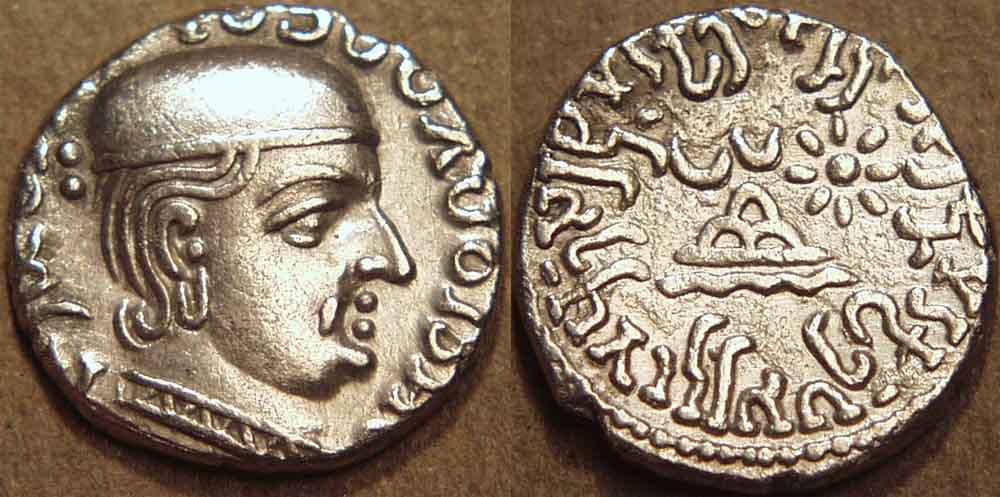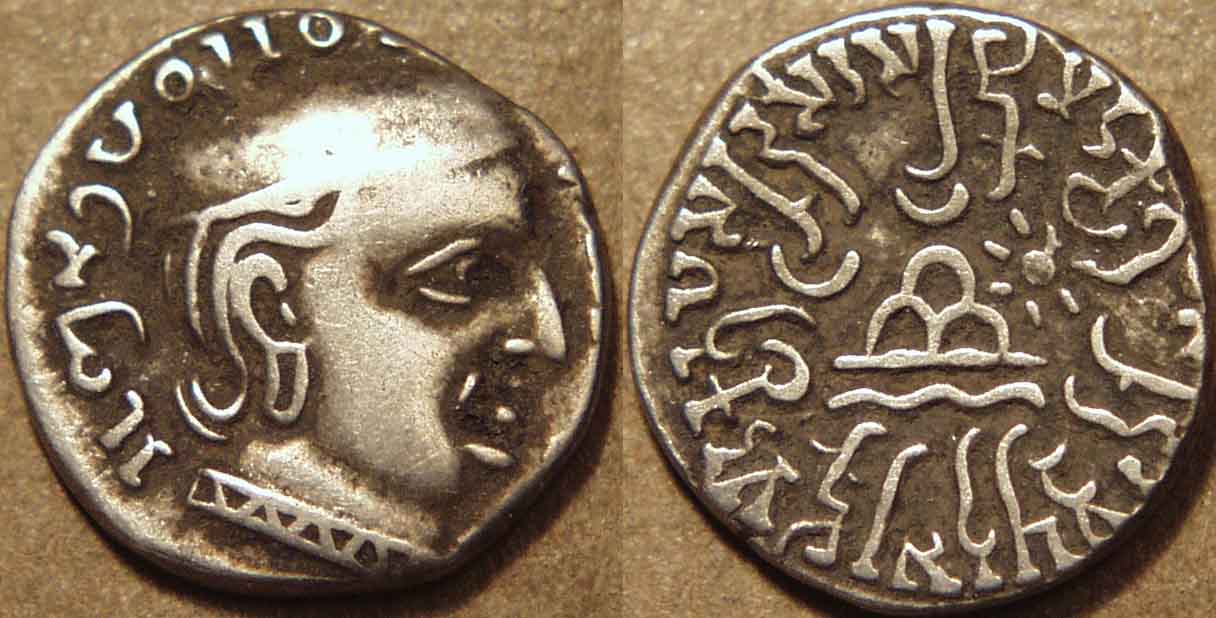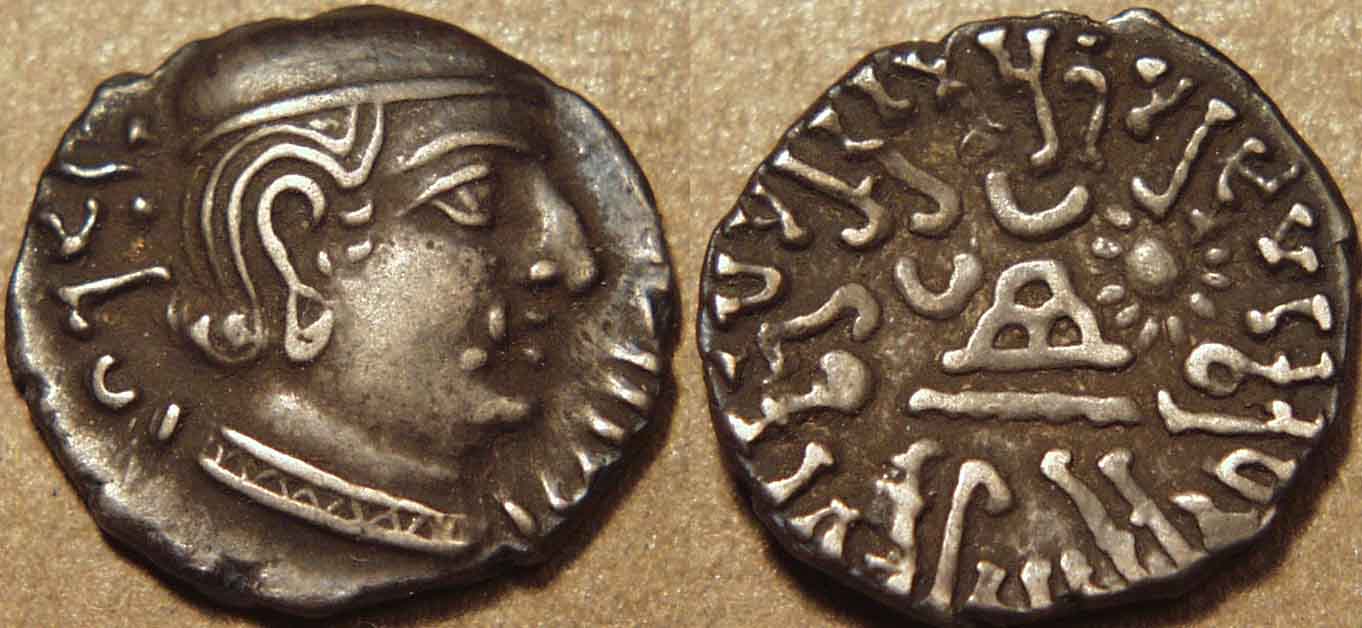
|
|
Rudrasimha I was the younger brother of Dāmazāda II and he initially issued some undated coins as kshatrapa. They carried the legend
Rajno mahakshatrapasa Rudradamnaputrasa Rajno kshatrapasa Rudrasihasa.
The use of the patronymic Rudradamnaputrasa marks this legend as belonging to mint A, as this was the form used for the patronymic on Dāmazāda's mint A coins.
Thus it appears that Rudrasimha issued his kshatrapa coins from mint A only, as no coins are known to carry what would be the logical mint B legend:
Rajno mahakshatrapasa Rudradamaputrasa Rajno kshatrapasa Rudrasihasa.
The style of the kshatrapa coins also fits with the style of Dāmazāda's mint A coins.
It appears that Rudrasimha started dating his coins at the same time as he assumed the title of mahakshatrapa, as there are no undated coins listing him with that title. The
first dated coins carry the date Saka 100 (= 178 CE assuming the Saka era started in the year 78 CE) and are known from both mints. So mint B appears to have started issuing
coins of Rudrasimha at this time. With the Rudrasimha mahakshatrapa coins, the stylistic differences between the coins of different mints start to diminish. The portraits are no
longer as distinct from one another. Also, the hills of the chaitya on the mint A coins are no longer as rounded and the pellets start to disappear. In year 107, the "foundation"
line of the chaitya also starts to exceed the length of the hill bases. After this time, therefore, it becomes more difficult to separate the coins by mint on stylistic grounds. Of
course the legend difference persists.
Arranging Rudrasimha's coins by mint sheds new light on the issue of the so-called "demotion" of this king to kshatrapa in the middle of his reign. In his British Museum
catalogue, Rapson had observed that he had coins of Rudrasimha that named him as kshatrapa and were dated 110 and 112! Since he also had coins naming Rudrasimha as
mahakshatrapa dated 103, 106, 109, 110, 113-116 and 118, the dated kshatrapa coins seemed to indicate that this king suffered some sort of demotion to kshatrapa in the
year 110 and then recovered his position as mahakshatrapa in the year 113. In their catalogue, Jha & Rajgor were able to add to the corpus of dated coins a kshatrapa coin
dated 111 and mahakshatrapa coins dated 100, 112 and 119 (among others). It appeared from J&R's data that Rudrasimha became mahakshatrapa in the year 100, remained
so until some time in the year 110, when he was reduced to kshatrapa again, and then regained the position of mahakshatrapa in the year 112.
Various theories were proposed to explain this seeming demotion and these have been discussed in detail by J&R. Rapson had suggested that Dāmazāda had
been succeeded not by his brother Rudrasimha but by his son Jīvadāman. He based his argument on a coin of Jīvadāman in the British Museum's
collection. At the time, the Museum owned five coins of this ruler, four of which carried the mint B legend and had dates 119-120 and the fifth of which carried the mint A legend
and had a date 1xx. Since Rapson was convinced that differences in legend marked different time periods, he guessed that the fifth coin must be earlier than 119 and
speculated that it might be dated 100-103 or 110-113, since these were dates that would fill "gaps" in the Rudrasimha sequence. His preferred dating was to 100-103. That
suggested that Jīvadāman actually succeeded his father Dāmazāda but was overthrown by his cousin Rudrasimha shortly thereafter. Rudrasimha's "
demotion"
mid-way through his reign might then be explained by Jīvadāman seizing power once again for a brief period. Alternatively, if the Museum's fifth coin was dated
110-113, it might simply mark a period during which Jīvadāman took power in a struggle with Rudrasimha. So this would still provide an explanation for Rudrasimha's
"demotion."
Rapson's theory was dealt a significant blow when coins of Rudrasimha as mahakshtrapa, dated 100, were found. In presenting mahakshtrapa Rudrasimha coins
dated 100 and 102, J&R point out that this means there is "no basis for placing [Jīvadāman] before Rudrasimha I." Further, J&R presented a coin (number 358) that
was "very similar" to Rapson's coin and was dated 11x, probably 119. This coin provided further evidence that Rapson's coin was probably not dated 100-103 and suggested
that it was probably dated 119. However, the number 9 was not conclusively visible on J&R's coin and so the possibility that Rapson's coin 288 was dated between 110 and
113 could not be ruled out. In particular, J&R had not even attempted to explain the differences in legends on the two coin types.
The two mint model, however, explains the differences in coin legends and thereby erases the "need" to find an early date for Rapson's coin. But it does nothing yet to
explain Rudrasimha's "demotion" to kshatrapa during the Saka years 110-113. Having rejected the idea that it was caused by a power struggle between Jīvadāman
and Rudrasimha, J&R considered other proposals and rejected all of them. These included the possibility that the usurper Isvaradatta took power briefly, that the Rudrasimha
kshatrapa coins from 110-112 were die engraver's errors, or that they were mules. J&R gave cogent arguments against each of these suggestions. But they acknowledged they
had no satisfactory explanation for Rudrasimha's apparent diminution of power. They concluded that it probably occurred at the hands of an outside dynasty, perhaps the
Satavahanas, as a familial struggle could be ruled out with the exclusion of Jīvadāman from any early reigns.
A major change to the chronology occurred when Senior published his catalogue, as he now had a coin naming Rudrasimha as mahakshatrapa that was dated 111! There
was therefore no longer a neat and convenient gap in the mahakshatrapa issues into which the kshatrapa issues could be placed chronologically. We now had coins naming
Rudrasimha as kshatrapa as well as coins naming him as mahakshatrapa for each of the years 110, 111 and 112, a seemingly irreconcilable situation. Senior summed up the
problem in a footnote, where he suggested that his S. 111 coin "surely indicates that the dated satrap issues were die engravers errors?"
Allocating the coins by mint, however, reveals an important new aspect of this problem. All the dated kshatrapa coins of S. 110-112 are from mint A and all the known dated
mahakshatrapa coins of the same years are from mint B. It would appear, therefore, that there could have been a "demotion" of Rudrasimha that took hold in the geographic
area around mint A, but that he maintained the position of mahakshatrapa in the area around mint B. Thus we are back to the situation that prevailed before Senior's S. 111
coin (Senior 333.41B) was published, only with the geographic detail created by the two mint theory.
Senior also published another coin that could perhaps bear on this problem and to which he referred in his footnote on the S. 111 coin: a coin of Rudrasena dated 112
(Senior 339.60AD). The coin names Rudrasena as mahakshatrapa and carries a legend that would locate it at mint A. Thus if the date on this coin is correct, it would suggest
that it was possibly Rudrasena who replaced his father as mahakshatrapa at mint A during the years 110-112.
|
 |
Rudrasimha I |

|
Rudrasimha I, as kshatrapa, silver drachm, "mint A"
c. 175 CE
Head of king right, blundered Greek legend around /
Chaitya (3-arched hill), river below, crescent moon and sun above, Brahmi legend around
Rajno Mahakshatrapasa Rudradamnaputrasa Rajno Kshatrapasa Rudrasihasa

|
 |
The mint A coins of Rudrasimha can be identified by the patronymic Rudradamnaputrasa, which was the form
used on the mint A coins of Dāmazāda II. There are no coins known naming Rudrasimha as kshatrapa from mint B. These kshatrapa coins are the last undated
Western Kshatrapa coins. |

|
Rudrasimha I, as mahakshatrapa, silver drachm, "mint B"
dated S. 100 (=178 CE)
Head of king right, blundered Greek legend around /
Chaitya (3-arched hill), river below, crescent moon and sun above, Brahmi legend around
Rajno Mahakshatrapasa Rudradamaputrasa Rajno Mahakshatrapasa Rudrasihasa

|
 |
The first dated Indian coin! Behind the king's head, we see the Brahmi symbol for 100, indicating the date in the Saka
era, started most probably by the founder of the dynasty, Chastana. This coin is from mint B, as we can tell by the patronymic Rudradamaputrasa and the unmistakable
portrait style. Coins dated 100, and naming Rudrasimha as mahakshatrapa, are also known from mint A. |

|
Rudrasimha I, as kshatrapa, silver drachm, "mint A"
dated S. 110 (=188 CE)
Head of king right, blundered Greek legend around /
Chaitya (3-arched hill), river below, crescent moon and sun above, Brahmi legend around
Rajno Mahakshatrapasa Rudradamnaputrasa Rajno Kshatrapasa Rudrasihasa
|
 |
This is an example of the apparently problematic coins that name Rudrasimha kshatrapa again in the middle of his
reign as mahakshatrapa! Rudrasimha became mahakshatrapa in the year S. 100, as we have no undated coins naming him as mahakshatrapa and S. 100 is the earliest date
we have. We have dated coins for all the years from 100 to 110 naming him as mahakshatrapa, from both mints. But here, out of the blue, we have a coin naming him as
kshatrapa again, dated 110! There are similar coins naming him as kshatrapa dated 111 and 112 also, and there are coins, such as the next one, naming him as
mahakshatrapa, with those same dates 110-112! In my paper,
A Simple Two Mint Model for Western Kshatrapa Coinage, published in Numismatic Digest 32-33
(2008-09), I have
pointed out that all the coins naming Rudrasimha as kshatrapa during these years are from mint A, while all the coins from this date naming him as mahakshatrapa are from
mint B. Why this happened is still not known; it is possible that Rudrasimha voluntarily reduced his title and gave the title of mahakshatrapa to his son, Rudrasena, in an
attempt to advance his chances of succeeding his father.
|

|
Rudrasimha I, as mahakshatrapa, silver drachm, "mint B"
dated S. 110 (=188 CE)
Head of king right, blundered Greek legend around /
Chaitya (3-arched hill), river below, crescent moon and sun above, Brahmi legend around
Rajno Mahakshatrapasa Rudradamaputrasa Rajno Mahakshatrapasa Rudrasihasa
|
 |
A mint B coin dated S. 110. Other coins like this are known for dates S. 111 and 112 as well. |

|
Rudrasimha I, as mahakshatrapa, silver drachm, "mint B"
dated S. 114 (=192 CE)
Head of king right, blundered Greek legend around /
Chaitya (3-arched hill), river below, crescent moon and sun above, Brahmi legend around
Rajno Mahakshatrapasa Rudradamaputrasa Rajno Mahakshatrapasa Rudrasihasa
|
 |
A mint B coin dated S. 114. Coins like this are known for dates as late as 119. |

|
Rudrasimha I, as mahakshatrapa, silver drachm, "mint A"
dated S. 117 (=195 CE)
Head of king right, blundered Greek legend around /
Chaitya (3-arched hill), river below, crescent moon and sun above, Brahmi legend around
Rajno Mahakshatrapasa Rudradamnaputrasa Rajno Mahakshatrapasa Rudrasihasa

|
 |
A mint A coin dated S. 117. Mint A coins after S 113 always name Rudrasimha as mahakshatrapa, until the last coins
dated S. 119. |

|
Rudrasimha I, as mahakshatrapa, silver drachm, "mint A"
dated S. 119 (=197 CE)
Head of king right, blundered Greek legend around /
Chaitya (3-arched hill), river below, crescent moon and sun above, Brahmi legend around
Rajno Mahakshatrapasa Rudradamnaputrasa Rajno Mahakshatrapasa Rudrasihasa
|
 |
A mint A coin dated S. 119. This coin is important, as it is very similar in style to the coin in the British Museum that
Rapson used to theorize that Jīvadāman may have had two reigns. It demonstrates that the BM coin of Jīvadāman must have been dated 119, and
that therefore Jīvadāman had just one reign.
|
|
|